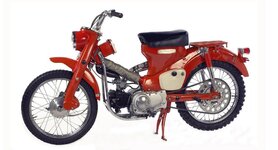Gold Supporter
- Messages
- 6,654
- Reactions
- 10,261
So Mike...like this?...That was a factory thing on the Trail 55 and Trail 90. The larger ring sprocket was held to a plate behind the smaller sprocket by four bolts. There was a tool kit below the seat in the panel where the key was. When the time came to change it to "Low" range you'd remove the link in the chain and drop it. Remove the four bolts holding the large ring sprocket to the plate and position it over the teeth in the small sprocket and put the bolts/nuts/washers through the teeth of the smaller sprocket matched up with the half holes in the larger ring sprocket and tighten well. The swing arm had plastic plugs in the tube cross cross brace. Inside that tube was and extra piece the you would add to the drive chain so it would be long enough to go around that now larger sprocket. As I recall it was quit a pain to on the trail. The tool kit wasn't the best. I think we just did them at home, before we took them out to ride the trails. I think it was '67 when they came up with the internal high/low change that used a wrench, and a year or so later it was made it so you could change it with your fingers. mine was the '67, I always carried a 12mm wrench.
The frames would be identical on the models shown and the trail bikes I would imagine No reason someone couldn't get the trail bike rear wheel, pull off the chain guard and switch wheels.

I have to admit, never seen that setup before.
Dean














